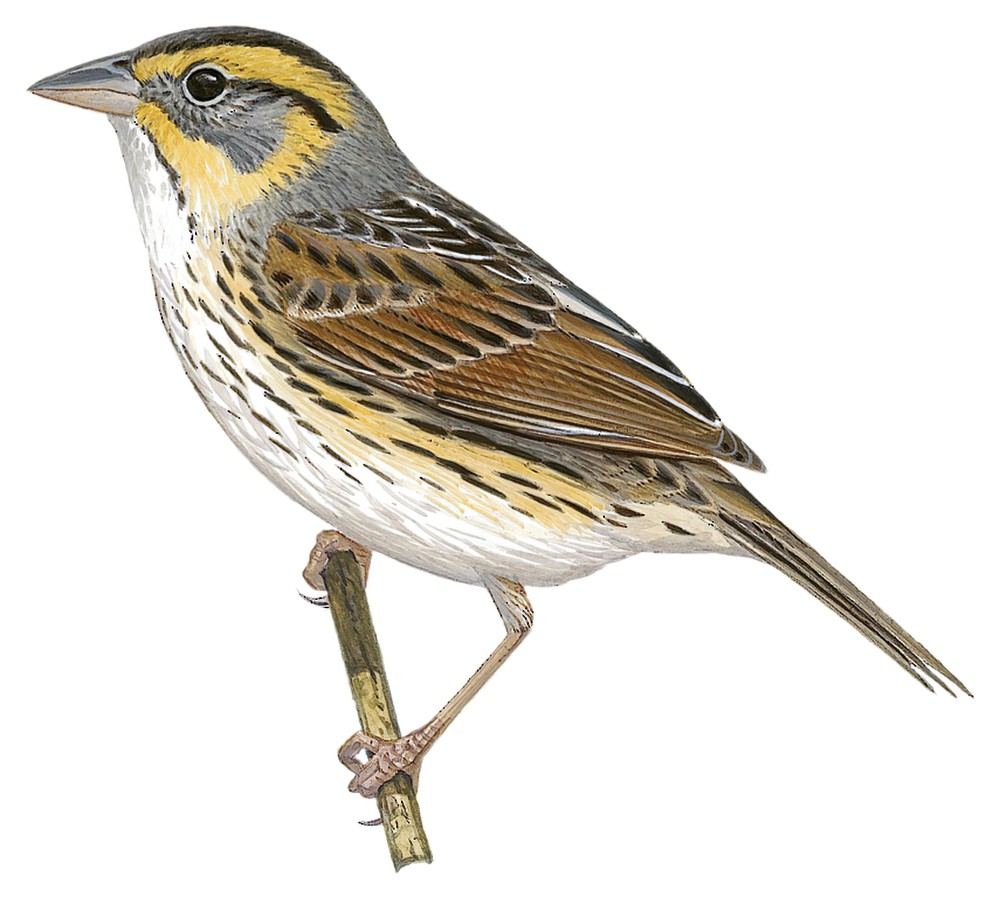Saltmarsh Sparrow / Ammospiza caudacuta

Saltmarsh Sparrow
SCI Name:
Protonym: Oriolus caudacutus Syst.Nat. 1 pt1 p.394
Taxonomy: Passeriformes / Passerellidae / Ammospiza
Taxonomy Code: sstspa
Type Locality: New York.
Author: Gmelin, JF
Publish Year: 1788
IUCN Status: Endangered
DEFINITIONS
AMMOSPIZA
(Passerellidae; † Saltmarsh Sparrow A. caudacuta) Gr. αμμος ammos sand; σπιζα spiza finch < σπιζω spizō to chirp; "Since the term Ammodramus Swainson belongs to Coturniculus, as already shown, another name is required for the group to which the former has been applied, and as there is none such available, it may be called Ammospiza, from αμ,μος [sic] harena, and σπιζα, fringilla, with Oriolus caudacutus Gmelin as the type." (Oberholser 1905); "Ammospiza Oberholser, Smiths. Misc. Coll., 48, p. 68, May 13, 1905—new name for Ammodramus Swainson, Dec., 1827, preoccupied." (Hellmayr, 1938, Cat. Birds Americas, Pt. XI, p. 504) (see Ammodramus).
Synon. Ammodramus, Passerina.
caudacuta / caudacutus
L. cauda tail; acutus sharp-pointed < acuere to sharpen to a point.
● ex “Sharp-tailed Oriole” of Latham 1782, and Pennant 1785 (Ammospiza).
● ex “Cola de agujas” of de Azara 1802-1805, no. 227 (Culicivora).
SUBSPECIES
Saltmarsh Sparrow (caudacuta)
SCI Name: Ammospiza caudacuta caudacuta
caudacuta / caudacutus
L. cauda tail; acutus sharp-pointed < acuere to sharpen to a point.
● ex “Sharp-tailed Oriole” of Latham 1782, and Pennant 1785 (Ammospiza).
● ex “Cola de agujas” of de Azara 1802-1805, no. 227 (Culicivora).
Saltmarsh Sparrow (diversa)
SCI Name: Ammospiza caudacuta diversa
diversa
L. diversus different, diverse < divertere to differ.
• "Arborophila diversa, sp. nov. ... Only the type was taken. No specimens of Arborophila cambodiana are available for comparison, but the present bird does not agree with the description of that species, though evidently closely allied." (Riley 1930) (subsp. Arborophila cambodiana).
• "Across the Western Andes of Perú, on the eastern side of the cordillera a little to the southward, the greater extent of the light coronal patch becomes a regular feature, combined with certain other characters, and it appears desirable to recognize a separate subspecies for the birds of this region. This form may be known as follows. Elaenia albiceps diversa, new subspecies TYPE from Cajabamba, northern Perú" (J. Zimmer 1941) (subsp. Elaenia albiceps).
• "To present a clearer discussion of the geographical variation of the species, I propose here as follows: Ficedula tricolor diversa Vaurie, new subspecies ... Differs very distinctly from F. t. cerviniventris from Manipur and Chin Hills by lacking in both sexes the dull orange coloration of the under parts, including the throat, characteristic of these populations, and by being larger (table 1). Similar to nominate tricolor from eastern Nepal (see discussion below) and Sikkim to northeastern Assam, but darker, more saturated." (Vaurie 1953) (subsp. Ficedula tricolor).
• "Frederickena unduligera diversa, new subspecies ... Similar to F. u. unduligera of the Rio Negro, Brazil, but females with under parts more brightly colored (orange-ochraceous instead of near buckthorn brown), anteriorly marked with blackish spots and crescents but not "barred," and posteriorly largely unmarked (not barred throughout). Male not certainly different from unduligera but possibly with a greater extension of unmarked black on the breast." (J. Zimmer 1944) (subsp. Frederickena unduligera).
UPPERCASE: current genus
Uppercase first letter: generic synonym
● and ● See: generic homonyms
lowercase: species and subspecies
●: early names, variants, mispellings
‡: extinct
†: type species
Gr.: ancient Greek
L.: Latin
<: derived from
syn: synonym of
/: separates historical and modern geographic names
ex: based on
TL: type locality
OD: original diagnosis (genus) or original description (species)












